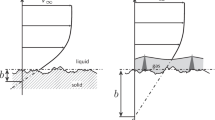Abstract
This paper investigates the nano-fluidic contact angle measurement by performing molecular dynamics simulations. The contact angle between a nano-water droplet and a platinum surface is important for the design of the porous catalyst layer in low-temperature fuel cells. The measurement can generally be conducted by an atomic force microscope (AFM). However, the interaction force between the water droplet and the probe tip of the microscope may influence the measurement results. This paper employs the molecular dynamics technique to investigate the offset of the contact angle measurement. Calculations are in two sets, one simulated the water molecules clustering on the platinum surface, and the other involved the AFM measurement of the contact angle. The former case presents the original contact angle between the nano-scale water droplet and the platinum surface; the offset of the contact angle measurement due to intrusion of the AFM probe is predictable from the latter case. For engineering purposes, we present a correlation between the offset angle and the AFM measurement locations.












Similar content being viewed by others
Abbreviations
- e b :
-
unit vector in body-fixed frame
- e s :
-
unit vector in space-fixed frame
- h :
-
the height of droplet spreading on solid surface (nm)
- q :
-
charge of atoms
- r ij :
-
distance between atoms in each pair (nm)
- r :
-
curvature radius of the droplet surface spreading on solid surface (nm)
- r′:
-
radius of contact area between the droplet and the solid surface (nm)
- ɛ0 :
-
dielectric constant (8.852 × 10−6)
- ɛoo :
-
energy at the minimum of the pair potential for water (0.6502 kJ/mol)
- ϕ, ξ, ψ:
-
Euler angles (degree)
- θ:
-
contact angle between the droplet and the solid surface (degree)
- σoo :
-
distance to the zero in pair potential for water (0.3166 nm)
- ω:
-
length projection of the distance vector on the x−y plane (nm)
- i, j :
-
separate atoms
References
Allen MP, Tildesley DJ (1987) Computer simulation of liquids. Oxford University Press, New York
Berendsen HJC, Grigera JR, Straatsma TP (1987) The missing term in effective pair potentials. J Phys Chem 91:6269–6271
Haile JM (1997) Molecular dynamics simulation-elementary methods. Wiley, New York
Kandlikar SG, Steinke ME, Maruyama S, Kimura T (2001) Molecular dynamics simulation and measurement of contact angle of water droplet on a platinum surface. In: Proceedings of 2001 ASME international mechanical engineering congress and exposition, New York, pp 343–348
Maruyama S, Kurashige T, Matsumoto S, Yamaguchi Y, Kimura T (1998) Liquid droplet in contact with a solid surface. Microscale Thermophys Eng 2:49–62
Maruyama S, Kimura T, Lu MC (2002) Molecular scale aspects of liquid contact on a solid surface. Thermal Sci Eng 10:23–29
Shi B, Sinha S, Dhir VK (2005) Molecular simulation of the contact angle of water droplet on a platinum surface. In: Proceedings of the 2005 ASME international mechanical engineering congress and exposition, Orlando
Spohr E (1989) Computer simulation of the water/platinum interface. J Phys Chem 93:6171–6180
Spohr E, Toth G, Heinzinger K (1996) Structure and dynamics of water and hydrated ions near platinum and mercury surfaces as studied by MD simulations. Electrochim Acta 41:2131–2144
Wang R, Cong L, Kido M (2002) Evaluation of the wettability of metal surfaces by micro-pure water by means of atomic force microscopy. Appl Surf Sci 191:74–84
Werder T, Walther JH, Jaffe RL, Halicioglu T, Koumoutsakos P (2003) On the water–carbon interaction for use in molecular dynamics simulations of graphite and carbon nanotubes. J Phys Chem B 107:1345–1352
Acknowledgments
National Science Council provided support under contract no. NSC 95-2218-E-007-001; National Center for High-performance Computing provided the high-speed computer facility.
Author information
Authors and Affiliations
Corresponding author
Rights and permissions
About this article
Cite this article
Fei, K., Chiu, C.P. & Hong, C.W. Molecular dynamics prediction of nanofluidic contact angle offset by an AFM. Microfluid Nanofluid 4, 321–330 (2008). https://doi.org/10.1007/s10404-007-0187-y
Received:
Accepted:
Published:
Issue Date:
DOI: https://doi.org/10.1007/s10404-007-0187-y




